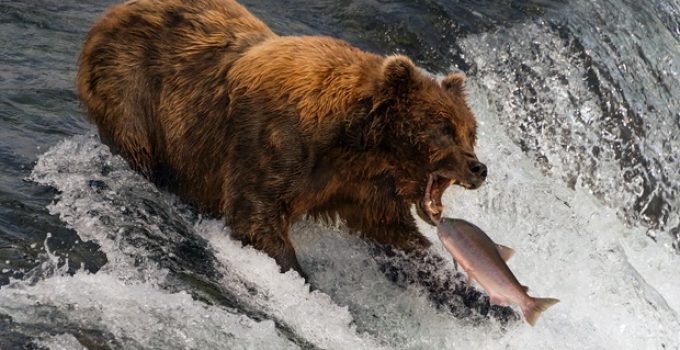Bears are omnivores—eating a mix of plants, insects, meat, and fish—but their diets vary dramatically by species and region. While polar bears rely heavily on seals, black bears may eat mostly berries and acorns. Grizzlies can devour everything from salmon to carrion. A bear’s diet is shaped by seasonal availability, ecosystem type, and biological adaptations, making them some of the most versatile feeders in the animal kingdom.
Dive Deeper
- Bear Diet Basics
- Species-Specific Diets
- Seasonal Feeding Patterns
- Table: What Different Bears Eat
- 🎯 Final Thoughts
- 📚 References
Bear Diet Basics
Bears belong to the family Ursidae, and most members are opportunistic omnivores, meaning they’ll eat what’s available:
- Plants: Fruits, roots, grasses, nuts
- Insects: Ants, termites, grubs, bees
- Fish & meat: Salmon, ungulates, carrion
- Other: Honey, eggs, even garbage in human-altered habitats
🧠 According to the Smithsonian’s National Zoo, bear species can consume up to 20,000 calories per day during hyperphagia, the intense feeding period before hibernation [1].
Species-Specific Diets
🐻 American Black Bear (Ursus americanus)
- Diet: ~85% plant-based
- Common foods: Berries, nuts, insects, small mammals, carrion
- Adapted to forested and suburban environments
🐻 Grizzly/Brown Bear (Ursus arctos)
- Diet: More animal protein than black bears
- Common foods: Salmon, moose calves, roots, berries, rodents
- Can consume up to 90 lbs of food per day in fall [2]
🐻❄️ Polar Bear (Ursus maritimus)
- Diet: 90–100% carnivorous
- Common foods: Ringed and bearded seals
- Occasionally eats bird eggs, kelp, or whale carcasses
🐻 Giant Panda (Ailuropoda melanoleuca)
- Diet: 99% bamboo
- Digestive system of a carnivore but adapted to a vegetarian diet
- May eat small animals or eggs on rare occasions
🐻 Asiatic Black Bear, Sun Bear, and Sloth Bear
- All are omnivores with regional variation
- Sloth bears specialize in termites and ants
- Sun bears eat honey, fruits, and small animals
🍃 A study published in Ecology found that dietary flexibility helps black bears thrive in fragmented landscapes and human-dominated areas [3].
Seasonal Feeding Patterns
Bears adjust their diets based on food availability:
- Spring: Roots, emerging plants, carrion from winter kills
- Summer: Berries, insects, fish (e.g., salmon runs), small prey
- Fall: Nuts, acorns, salmon (grizzlies), hyperphagia sets in
- Winter: Most bears hibernate and don’t eat at all
📈 According to the National Park Service, grizzly bears may gain up to 3 lbs per day during peak feeding season [4].
Table: What Different Bears Eat
| Bear Species | Diet Type | Primary Foods | Notable Traits |
|---|---|---|---|
| Black Bear | Omnivore (~85% plant) | Berries, nuts, insects, small mammals | Extremely adaptable |
| Grizzly/Brown Bear | Omnivore with more meat | Salmon, berries, ungulates, carrion | Top predator where salmon are available |
| Polar Bear | Carnivore | Seals, whale carcasses | Marine mammal specialist |
| Giant Panda | Herbivore (~99%) | Bamboo, occasionally eggs or meat | Vegetarian with carnivore anatomy |
| Sloth Bear | Insectivore-leaning | Termites, fruits, honey | Lacks upper incisors to suck insects |
| Sun Bear | Omnivore | Fruits, insects, honey | Smallest bear, tropical feeder |
🎯 Final Thoughts
So, what do bears eat? Almost anything—but it depends on the bear.
- Black and brown bears eat a plant-heavy but flexible omnivore diet
- Polar bears rely on meat, mainly seals
- Pandas break the mold with their almost-exclusive bamboo intake
- Seasonal variation plays a key role in what and how much they eat
Their diet reflects not only their evolutionary background, but also their ecological adaptability, making bears a fascinating case study in survival through dietary diversity.
📚 References
- Smithsonian’s National Zoo. “Bear Diets and Feeding Behavior.” National Zoo & Conservation Biology Institute, 2023.
https://nationalzoo.si.edu/animals/bears - Robbins, C. T., et al. “Grizzly Bear Nutrition and Energetics.” Wildlife Monographs, vol. 84, 1983, pp. 1–46.
https://doi.org/10.2307/3830546 - Baruch-Mordo, S., et al. “The Carnivore’s Dilemma: Diet Versatility and Resilience in Human-Dominated Landscapes.” Ecology, vol. 95, no. 5, 2014, pp. 1122–1131.
https://doi.org/10.1890/13-0832.1 - National Park Service. “Grizzly Bear Feeding Patterns.” NPS.gov, 2023.
https://www.nps.gov/subjects/bears/feeding.htm
